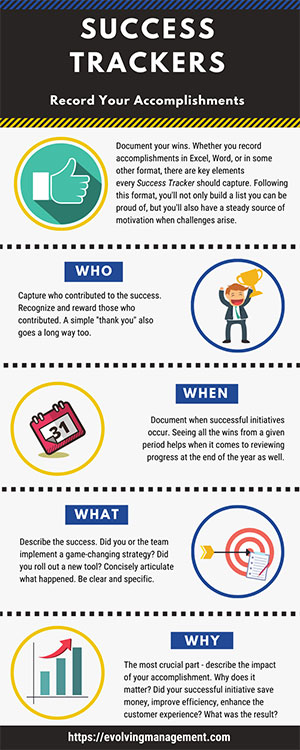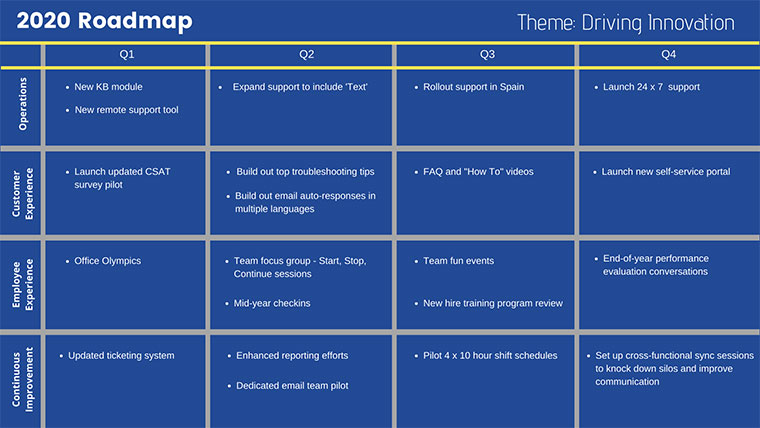Date Published January 3, 2020 - Last Updated December 10, 2020
With 2019 at an end, it’s time to reflect on the progress made in the past year and get ready for what’s coming next. I’ll run through the final items to check off for 2019 and help ensure you have all you need in place to develop your 2020 roadmap, setting yourself and your team up for success.
2019 in Review
Did your team accomplish everything they set out to achieve in 2019? Did everything go to plan? If things didn’t work out as expected, did you course correct enough? For some teams and organizations, was there even a plan?
Did your team accomplish everything they set out to achieve in 2019?

Reaching the end of the year brings a time for reflecting on the year that was, not only as a leader but as individual contributors, too. Whether its formal evaluations or just recap conversations, every support professional should know whether 2019 was a good year or not for themselves. Provided there are one-on-one conversations throughout the year, no one should ever be surprised with how they are viewed from a performance perspective.
To help with these conversations, leaders and members of all teams should maintain Success Trackers, detailing wins, both big and small. Throughout the year, capture all positive feedback or key contributions to projects or initiatives. Doing so will help to recognize and reward team performance.
Encourage team members to keep track of their accomplishments. Whenever they have a day that doesn’t go as well as expected, they can refer to their Success Tracker, and reflect on the wins they have had.
For more on building your own Success Tracker, check out the infographic below.

Click to enlarge
Critical Year-End Leadership Tasks
At year-end, business leaders need to ensure that they have given adequate thought to future initiatives and investments. Technical support and service management teams are excited by new tools and software that make their lives easier. Knowing this, leaders need to ensure they stay informed of the latest trends, technology, and requirements from customers, both internally and externally, factoring these into the budget planning process. Through integrated business planning with cross-functional partners, support leaders should have a solid plan for what’s required for 2020. To be more proactive than reactive, ask team members about what they need in terms of tools and technology throughout the year. When the ROI is obvious, prioritize investment in the budget plan.
Theme Your Year in 2020
What’s your theme for the year ahead? If you were to look back at the end of 2020, how would you like to describe what you and the team accomplished? In a few words, can you summarize the strategy to the team? Think of a theme as a unifying way to tie all initiatives together before building the roadmap. Here are a couple of examples, I’ve used with some of the customer and tech support teams I’ve managed throughout my career, as well as a couple of others for your consideration:
- Break Down the Walls
- Smarter, Not Harder
- Game-Changers
- Proactive Instead of Reactive
- People Make the Difference
- Drive Continuous Improvement and Eliminate Waste
- Focus on Small Wins
Build Roadmap Ideas
Once your theme is set, start brainstorming what you want to accomplish. The best way to do this is with your team. Start with brainstorming ways to improve in the year ahead, using the theme selected as your guide. Even if an idea suggested isn’t feasible for 2020, make a note of it still. Perhaps it’s too big of a project for this year, so it needs to be deferred or rolled into a larger plan down the line.
It’s one thing to have a list of new initiatives to tackle, but can you do them all with everything else on your plate? During your brainstorming sessions with your team, create a Stop List. Note the items that no longer provide value that should be stopped. Doing so allows you to pivot focus to include new initiatives that are worthy of the effort.
Remember that budget plan from earlier? Make sure your roadmap aligns with it, not only from a technology perspective but also headcount-wise. Ensure that any potential new initiative has the right amount of resourcing to produce the desired results. It’s at this point where your list of possible roadmap items should be put in front of relevant leaders to confirm that directionally, your group will work on the right things too. Consult with IT leaders for alignment as well as circulate and share your plan with other cross-functional leaders. There could be overlap or opportunities to share responsibilities on some initiatives also.
Put the 2020 Roadmap Together
Since you brainstormed ideas with your team, it’s time to put the final plan together. I recommend categorizing all agreed-upon roadmap initiatives into four buckets:
-
Operations. Include items that need to be accomplished to improve or stabilize your support team’s efforts.
-
Employee Experience. This category includes anything related to investing in the team itself, like professional development.
-
Customer Experience. Whether your team supports internal or external customers, this category is reserved for projects that make the customer experience better.
-
Continuous Improvement. List transformative projects that require significant resources and investment.
Take all the initiatives noted and place them visually in these categories, using a swim-lane view. Each lane should be broken into fiscal quarters (Q1 through Q4) to give some structure to when the action will happen. Depending on the initiatives you plan on tackling, there could be a case made to separate into a monthly view.
Check out the example below for what a potential roadmap could look like using this approach.

Final Thoughts
Everyone wants to be part of a team that embraces change and shows progress. It’s demotivating when things never change. Providing technical support or service management often means that team members run from one fire to the next. When new changes that surprise them are rolled out, they are not only caught off guard, they become frustrated. By working on the 2020 roadmap together, leaders gain credibility, lessening the chaos, by showing their cards in plain sight.
Developing the 2020 roadmap, together with your team, is both fun and engaging. As a leader, once complete, ensure you put the final plan in front of the team in your first meeting of the year. Show them the strategy for what’s coming. Refer to the roadmap throughout the year, to confirm whether the team is still on track. Make any necessary course corrections, as well. From an engagement perspective, knowing what’s coming allows team members to raise their hand to possibly volunteer to help as well. Whenever team members can take a more active role with a project, it can provide them with growth opportunities, too. Lastly, celebrate accomplishments with the team when certain milestones or significant projects are checked off as well.
Good luck with building your 2020 roadmap.
Chris Hanna has built and led teams that support the customer experience across a variety of different industries, including a global technical support team. He’s passionate about developing high-potential talent and game-changing cultures, through continuous improvement efforts focused on enhancing both the employee and customer experience. As the founder of Evolving Management, Chris provides solutions to help leaders and companies rethink and evolve their approach to managing. Chris also hosts a business podcast—The Chris Hanna Show—where he shares ways for leaders to improve their impact, productivity, and performance. Connect with Chris on Twitter @chrishannashow, Instagram , LinkedIn, or at [email protected].